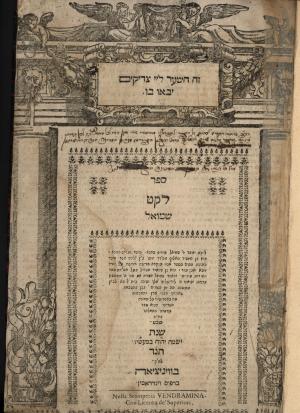Obj. ID: 38984
Jewish printed books Leket Shmuel by Shmuel Feibush Ben Yospha Katz, Venice, 1694

This text was prepared by William Gross:
Only edition of this midrashic compilation on various subjects with a supplement entitled Derush Shemu’el on the Torah by R. Samuel Feivush ben Joseph Yuzpa Katz. He was a grandson of R. Joshua Falk (Perishah u-Derishah) and served as sofer in Lublin. Samuel was forced to flee that city in 1656 due to pogroms, settling in Vienna, where he was appointed the city scribe. Here too, in 1670, Samuel was compelled to leave with the expulsion of the Jews from Vienna, going to Erez Israel. The title page states that Leket Shemu’el is a compilation by Samuel, provides the names of his antecedents, the titles of their books. The title page is dated in the month of Shevat “may the Lord rejoice in his works” (Psalms 104:31) 454 (January 17/February 15, 1694). The colophon dates completion of the book to Rosh Hodesh Iyyar “Because you have been כי היית (455 = 30 Nissan, Friday, May 4, 1695) my help, therefore in the shadow of your wings I will rejoice” (Psalms 63:8). It is possible, the press being owned by non-Jews, that work was completed on the second day of Rosh Hodesh, 1 Iyyar (May 5), a Saturday. The verso of the title page has Samuel’s introduction, in which he relates his experiences and mentions that his mother, grandmothers, and an aunt are buried Jerusalem, the latter beside her husband, within four amot of the prophet Zechariah. There are approbations signed by nineteen rabbis, and then the text in two columns in small rabbinic type.
Entries in Leket Shemu’el are arranged alphabetically, beginning with man (19 entries), man (11), avot (36), Aaron (19) Aaron (39). Elia (9), ahavah (4), Erez Israel (6) man and wife (16). the nations (8), the Temples (9), synagogues (3), and numerous others, concluding with tefillah (6), and teshuvah (4). The entries under each subject are of varied length, ranging from a few lines to several columns. The first entry under Messiah (30b-31a) states that the time for redemption passed many years ago (1670) but that the Messiah will reappear in forty years (1714). This is understood to be a reference to Shabbatai Zevi, inserted into Leket Shemu’el by the adherents of that false Messiah. There is an index of sources (41a-42b), definition of abbreviations (42b-43a), errata (43a), pidyon neFezh copied from Zikkaron Zion, and against the yezer ha-Ra (53b). Derush Shemu’el (54a-64b) on the weekly Torah readings and on Pesah, Song of Songs, Shabbat Teshuvah, Yom Kippur, Sukkot, and errata (64b) conclude the book.
On the pages 30B and 31AA of this book is a section entitled "Moshiach". In the text are references to Shabbai Tzvi.
The Vendramin Hebrew press was established in 1630 by Giovanni Vendramin, who thereby broke the monopoly enjoyed by the Bragadin family in Venice. The press eventually joined with that of Bragadin, however, and the combined presses continue to operate well into the 18th C.
Only edition. 64 ff. folio



